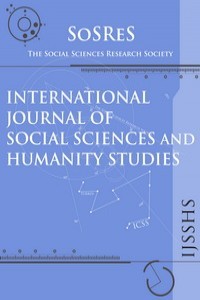CHARACTERISATION OF TIME-RELATED UNDEREMPLOYMENT IN A SOUTH AFRICAN MUNICIPALITY: A CASE OF BUSHBUCKRIDGE, MPUMALANGA PROVINCE
CHARACTERISATION OF TIME-RELATED UNDEREMPLOYMENT IN A SOUTH AFRICAN MUNICIPALITY: A CASE OF BUSHBUCKRIDGE, MPUMALANGA PROVINCE
Time-related underemployment, labour underutilisation, employment, labour market South Africa,
___
- Anderson, S. & Winefield, A. H. (2011). The Impact of Underemployment on
- Psychological Health, Physical Health, and Work Attitude. In Maynard, D. C. & Feldman, D. C (Eds.), Underemployment: Psychological, Economic and Social Challenges. New York: Springer. Barker, F. (2007). The South African Labour Market: Theory and Practice. 5th edition. Pretoria: Van Schaik Publishers.
- Beukes, R., Fransman, T., Murozvi, S. & Yu, D. (2016). Underemployment in
- South Africa. ERSA working paper 575. Blanden, J., & Machin, S. (2003). Cross‐Generation Correlations of Union Status for Young People in Britain. London, Centre for Economic Performance.
- Boeri, T. & Van Ours, J. (2013). The Economics of Imperfect Labour Markets.
- Edition, Oxford, Princeton University Press. nd Borgen, W. A., Amundson, N. E. & Harder, G. (1988). The Experience of
- Underemployment. Journal of employment counselling, 25(4), 149-159. Cam, S. (2012). Involuntary Part-time work in Britain: Evidence from Labour
- Forcer Survey. Industrial Relations Journal, 43(3), 242-260. Canada 2020 (2014). Unemployed and Underemployed Youth: A Challenge to
- Canada Achieving its Full Economic Potential. A Background Paper, June. Canadian Labour Congress (2014). Underemployment is Canada’s Real Labour
- Market Challenge: A Profile of Canada’s Labour Market. Research Note, March. Cazes, S. & Verick, S. (2013). Introduction and overview. In Cazes, S. & Verick,
- S. (Eds.), Perspectives on Labour economics for Development. Geneva, International Labour Organisation (ILO). Clogg, C. C., Sullivan,T .A. and Mutchler, J. E. (1986). Measuring underemployment and inequality in the work force. Social Indicators Research, (4), 375—393.
- Domfe, G., Osei, R. D. and Ackah, C. (2013). Determinants of Types of
- Underemployment in the MiDA Intervention Zones of Ghana. Developing Country Studies, 3(12), 33-47. Feldman, D. C. (1996). The nature, antecedents, and consequences of underemployment. Journal of Management, 22, 385-407.
- Gallup (2013). Underemployment in the MENA Region: Young people in MENA are in need of good jobs. December.
- Glyde, G. P. (1977). Under-employment: Definition and Causes. Journal of Economic Issues, 11(2), 245-261.
- Greenwood, A. M. (1999). International definition and prospects of underemployment statistics. Paper prepared for the “Seminario sobre Subempleo” organized by the Departamento Administrativo Nacional de Estadísticas (DANE) and the Universidad Javeriana, Bogotá, Colombia, 8 to 12 November, 1999.
- Translated from Spanish. At http://www.ilo.org/wcmsp5, June 2016.
- Hussmans, R. (2007). Measurement of Employment, unemployment and underemployment-current international standards and issues in their application,
- ILO Bureau of Statistics. www.ilo.org/wcmsp5/groups/public/. June 2016.
- Johnson, G. J. & Johnson, W. R. (2000). Perceived overqualification, positive and negative affectivity, and satisfaction with work. Journal of Social Behaviour and Personality, 15, 157-184.
- Jensen, L. & Slack, T. (2003). Under-employment in America: measurement and evidence. American Journal of community Psychology, 32(2), 21-31.
- Kjeldstad, R. and Nymoen, H. (2012). Underemployment in a gender segregated labour market. Economic and Industrial Democracy, 33(2), 207–224.
- Laurie, A. (1997). Report I: sixteen International conference of labour and statisticians. At http://www.ilo.org/wcmsp5/groups/public/---dgreports/--- stat/documents/meetingdocument/wcms_088362.pdf. At June 2016.
- Mathebula, I. (2013). The determinants of time-related underemployment in South
- Africa. Pretoria: Statistics South Africa. Maynard, D. C. & Feldman, D. C (2011). Introduction. In Maynard, D. C. &
- Feldman, D. C (Eds.), Underemployment: Psychological, Economic and Social Challenges. New York: Springer. National Bureau of Statistics (2015). Unemployment/ under Lagos, NBS ‐employment watch.
- Northern Ireland Statistics and Research Agency (2015). Underemployment in
- Northern Ireland: Labour Force Survey. June. O’Brien, G. E. (1986). Psychology of work and unemployment. Chichester, Wiley.
- Osborn, D., Cutter, A. & Ullah, F. (2015). Universal sustainable development goals Understanding the Transformational Challenge for Developed Countries.
- Report of a study by stakeholder forum, May. Parkin, M., Antrobus, G., Baur, P., Bruce-Brand, J., Kohler, M., Neethling, L., Rhodes, B., Saayman, A., Schoer, V., Scholtz, D., Thomson, K. and Van der Merwe, J. (2013). Economics: Global and Southern African Perspectives. Cape Town, Pearson.
- Reynolds, J. & Aletraris, L. (2010). Mostly Mismatched With a Chance of
- Settling Tracking Work Hour Mismatches in the United States. Work and Occupation, 37(4), 476-511. Rogers, J. K (2001). There’s No Substitute: The Politics of Time Transfer in the teaching Profession. Working and Occupations, 28, 64-90.
- Schoeman, C.H., Botha, I. and Blaauw, P.F. (2010). Labour conflict and the persistence of macro underemployment in South Africa. South African Journal of
- Economic and Management Sciences, 13(3), 272-292. STATSSA (2015). Quarterly Labour Force Survey: quarter 1. Pretoria.
- Tal, B. (2013). Dimensions of Youth Employment in Canada. Toronto, CIBC Economics, June.
- Wilkins, R. (2006). Personal and Job Characteristics Associated with
- Underemployment. Australian Journal of Labour Economics, 9(4), 371 – 393. Wilkins, R. & Wooden, M. (2011). Economic Approaches to Studying
- Underemployment. In Maynard, D. C. & Feldman, D. C (Eds.), Underemployment: Psychological, Economic and Social Challenges. New York: Springer. Yu, D. (2009). The comparability of Labour Force Survey (LFS) and Quarterly
- Labour Force Survey (QLFS). Stellenbosch Economic Working Papers 08/09. Stellenbosch: Stellenbosch University.
- Başlangıç: 2009
- Yayıncı: Sosyal Bilimler Araştırmaları Derneği
RETENTION OF EDUCATORS: THE ROLE OF LEADERSHIP, EMPOWERMENT AND WORK ENGAGEMENT
Paul-Francois Muzindutsi, Diana Viljoen
A. Yavuzaslan, A. Barişçil, Maria Fekete Farkas
C. M. Mbajiorgu, A. A. Asha, S. O. Mmusi
EXPLORING THE ASSOCIATION BETWEEN COMMUNITY COHESION AND CRIME IN THE REPUBLIC OF SOUTH AFRICA
